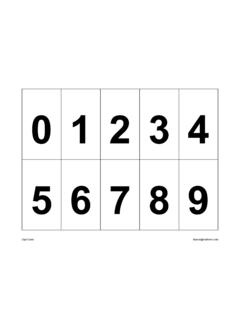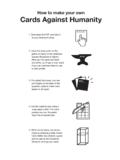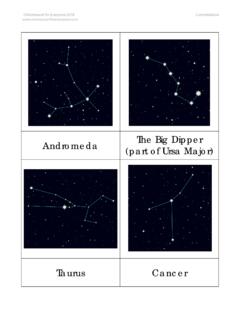Transcription of Cardiology Flash Cards - Brain 101
1 Cardiology Flash CardsCardiology Flash CardsEKG in a nut shellEKG in a nut SystemAnalyzing EKGStep by in Analyzing ECG'S1. Rhythm: - Regular _ Sinus, Junctional or Ventricular . - Irregular _ Regular irregularity, or irregularirregularity 2. Rate: - Normal _ (60-100 BPM) - Bradycardia _ ( less than 50) - Tachycardia _ ( More than 100) in Analyzing ECG'S3. P-Wave:-normally well rounded, followed by +ve in leads I, II, V4 & V6 , -ve in avF -Biphasic in V1 .-Should not exceed 2-3 duration .11 sec -Abnormality: Notched, wide, _ amplitude -Best lead to evaluate is II . in Analyzing ECG'S4. PR-interval:-Normally: Isoelectric ( sec)-Abnormality: a.
2 Short _ WPW Delta Wave b. Prolonged _ 1 AV in Analyzing ECG'S5. QRS complex: i. Duration _ sec. [2 boxes] ii. Amplitude _ standard LL > 5 mm _ CL V1, V6 = 5 mm _ CL V2 V5 = 7 mm _ CL V3 V4 = 9 mm iii. Timing of intrinsicoid deflection the length oftime that allow the impluse to travel from endo ->epicardium. iv. R-wave progression in the chest of Rhythm!Prolongation over seconds suggests a delay in the conductionsystem between the SA node and the AV node indicating a firstdegree heart block. When it takes two or three P-waves to initiatea QRS complex this is termed a 2:1 or 3:1 type second degreeheart block.
3 When the P-R interval becomes progressively longeruntil a QRS complex is dropped and then the process repeats,this is called a Wenckebach phenomenon, (a type of seconddegree Mobitz I block). If the QRS complex is periodically blockedwithout lengthening of the P-R interval this is called a Mobitz IIblock.!A third degree block exists when the P and the QRS waves areentirely disassociated. These blocks often result from interferencealong some part of the His-Purkinje system which can usually belocated by examining the chest leads such as Vl-V6 to determineif it is a right or left bundle branch block as well as its Axis in a Glance!
4 Using leads I and aVF the axis can becalculated to within one of the four quadrantsat a glance.! If the axis is in the "left" quadrant take yoursecond glance at lead IN A GLANCE!both I and aVF +ve = normal axis!both I and aVF -ve = axis in theNorthwest Territory!lead I -ve and aVF +ve = right axisdeviation!lead I +ve and aVF -ve!lead II +ve = normal axis!lead II -ve = left axis of 1 A-V Block!Prolongation of A-V conduction time (P-R)interval to or more.!P-R interval usually represents delay in theAVN, but at times it may reflect delays eitherabove Intra-atrial or below HIS Purkinje the degree AV block can be due to:!
5 Inferior MI,!Digitalis toxicity!Hyperkalemia!Increased vagal tone!Acute rheumatic fever! A-V Block!When some of the atrial impulses fail toreach the ventricle because of impairedcaonduction.!Types:"Type I Wenckeback "Type II Mobitz I Mobitz I Wenckebach !Prolonged P-R interval prior the drop {P} wave!Associated with:"Rheumatic HD"Acute inferior MI"Digitalis or Propranolol effect.!Chronic 2 type (I) associated with:"Chronic Ischemic HD"Aortic Valve disease."Mitral Valve Prolapse."ASD Atrial Septal Defect " I Mobitz I Wenckebach !Second degree AV block type I occurs inthe AV node above the Bundle of His.!Treatment is usually not indicated as thisrhythm usually produces no II Mobitz II !
6 Its is usually associated with constantprolonged PR interval followed by one Pwave is not conducted to the ventricles.!QRS usually widened because this isusually associated with a bundle branchblock.!This block usually occurs below theBundle of His and may progress into ahigher degree II Mobitz II " It can occur after an acute anterior MI due to damagein the bifurcation or the bundle branches." It is more serious than the type I block." Treatment is usually artificial Degree Heart Blocks (CompleteThird Degree Heart Blocks (CompleteAV Dissociation)AV Dissociation)"Third degree blocks are characterized by a complete AV nodalblock resulting in no depolarization of the ventricles ( noventricular contraction takes place).
7 "The electrical signal from the SA node is blocked between theatria and ventricles of the heart. This conduction dysfunctiongenerally occurs between the AV junction and the bundle of His."Therefore, the ventricles must create their own impulse in orderfor contraction to occur. Both the atria and ventricles functionas two separate units each with its own rate (atria, 60 bpm andventricles, 20-40 bpm)."This is a lethal dysrhythmia due to the fact that it can evolveinto ventricular standstill or asystole. Since the independentfiring rate of the ventricles is 20-40 bpm, perfusion of the entiresystem will not be adequate enough to sustain life.
8 Causes ofthird degree heart block include Digitalis toxicity, MI andmassive heart disease. Patients with third degree heart blockusually need a Hemi-BlockAnterior Hemi-Block1. LAD (-60 )2. Small Q Lead (I) Small R Lead (III) Deep S Lead (III)3. Normal QRS4. Delayed internsicoidin aVLPosterior Hemi-BlockPosterior Hemi-Block1. RAD (+120 )2. Small R Lead (I) Small S Lead (III) Small Q Lead (III)3. Normal QRS4. No evidence of :HINTS:++++++----PosteriorPHB------++++A nteriorAHBL L aVFaVFL IIIL IIIL IIL IIL L aVLaVLL IL Branch BlockBundle Branch BlockLBBBLBBBV1 QS or rSV6 Late intrinscoid &No (Q) waveL1 Morophasic wave,No (Q) waveRBBBRBBBV1 late intrinscoid, Mshaped QRS (RSR )sometimes wide (R)V6 Early intrinscoid,wide (S) waveL1 Wide (S) waveIn Both (QRS) is Secs.
9 Or Bundle Branch Block!Same criteria for LBBB & RBBB, But the QRSis ( ) Conduction Defect Delay (IVCD)!Wide QRS > Secs!A lesion in the ventricular conduction,slower spread of activation through out theventricle.! Always check (P) wave & (PR) preceedingeach abnormal QRS, to differentiatebetween Supraventricular & Ventricularrhythm.!Prolonged QT premature Beats (APB)Atrial premature Beats (APB)!Ectopic focus discharges an earlyimpulse other than SAN!!Criteria: (early). looking (P) by long internal but not a fullynot a fullycompensatorycompensatory result in drop (P), with Non-conducting Prematura Atrial Contraction (PAC)Atrial Contraction (PAC) ventricular Beat!
10 Timing - early (Premature)!(P) wave - absent, or retrograde.!QRS - wide & Bizarre!Compensatory pause following QRS.!Types:1. (R on T) malignant VPC - Very early2. Interpolated VPC - doesn t interrupt the normalrhythm manner, sandwiched between (2) End diastolic - shortened PR interval & there is norelation between P & {CONT.}!Another classification for VPCs:!Unifocal - Look alike.!Multifocal - Looks different.!Timing of occurance:!Bigiminy (2 PVCs) Couplet.!Trigiminy (3 PVCs) Triplets!Quadgiminy (short run of VT)Abnormal Heart RhythmCardiac atrial tachycardia (PAT)!Rate: 150-250 / Min!QRS: Normal in configuration.








